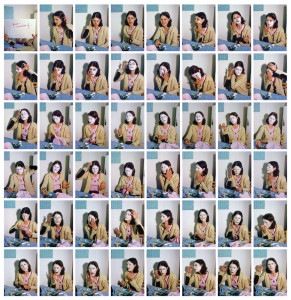
Suzy Lake, “A Genuine Simulation of…” (1973-74)
Required Reading:
“Updated: Matthew Barney, The Cremaster and the Markers of an Invisible Masculinity” by Xavier Lopez Jr.
Why we’re doing this:
A ritual is a series of actions or type of behavior regularly and invariably followed by someone. There are a variety of rituals, both public and private, but repetition is central to all of them. The rituals we are most familiar with might include birthdays, holidays, religious ceremonies, elections, and even possibly news cycles.
An example of art utilizing ritual is Marina Abramovic’s violent performance, “Rhythm 10” (1973), which involves repeatedly striking knives between her fingers, recording the process with an audio recorder, and then repeating the performance in time with the audio recorder.
Viennese Actionism, such as Hermann Nitsch in “6-Day Play” (1998), is an extreme example of ritual where performers subject their bodies to mutilation and sadomasochistic acts.
Another example is Suzy Lake’s “A Genuine Simulation of…” (1973-74) [pictured above] which consists of a series of performative photographs of the artist in which she has applied varying amounts of makeup. The work questions the rituals of femininity and the representation oneself. Each of these examples engages with questions of gender: How does gender relate to violence, what specific rituals relate to different genders, and how does repetition play a role in defining gender?
PROCESS:
Think about the role of repetition and gender in rituals. Create your own ritual. What is the motivation behind your ritual? Think about historical rituals, religious rituals, celebratory rituals, and artistic rituals. In your ritual, is repetition used in an expressive or utilitarian way? This performance asks you to take up these questions as you consider ritual and gender. Be prepared to discuss these ideas in your artist statement and critique.
- Brainstorm ideas for your ritual performance in a sketchbook. Do research on your favorite ideas. You will present this brainstorming and research to the class for feedback.
- After selecting your idea, you will perform your ritual on your scheduled day. Feel free to engage the class or others as necessary.
- In addition to your performance, please prepare an artist’s statement for incorporation into, display alongside of, or distribution with your work. Your statement should consider the following questions:
- What is this work about? (This is the idea, theme, message, or concept for your piece. Think of this as the thesis statement for your work.)
- Why do you want to do this work? (This is your explanation of the importance of the work and what it means to you)
- How will you do this work? What is it made of or out of? (This is how you envision the performance happening—medium/a, actions, texts, audience/performer relationship, etc.)
- What do you want this work to do or accomplish? (This is the outcome or experience you anticipate for the work)
- How does it relate to gender?
4. Make sure you have arranged for someone (probably someone else in the class) to document your performance (probably, though not necessarily via video and still photographs)
5. There will be a class critique of the performance.
6. After completing the performance, you will complete a self-analysis on Angel of elements/principles of design in the piece you performed.
- Discuss your work in terms of the components of an artwork (subject/form/content/context)
- How does the work engage with elements and principles of design continued from the study of 2 and 3 dimensional design such as balance, color, contrast, direction, reflection, repetition, scale, shape, value/brightness, and space?
- How does the work engage with the elements of 4 dimensional design (architecture, topography, light, movement, sound, and time)?
- How does the work engage with the principles of 4 dimensional design (causality, duration, energy dynamics/intensity, interactivity, musicality, simultaneity/juxtaposition, spatial relationships, speed, and transitions)?
7. Upload documentation of your performance to our YouTube Channel.
- sketchbook planning – 2pts
- artist statements – 3pts
- completion of the performance – 4pts
- self-analysis of elements/principles of design in the piece you performed – 8pts
- participation in critique – 2pts
- documentation quality and on-time upload – 2pts